Sulfidated Nano Zero-Valent Iron Sludge Biochar Composites for Efficient Tannic Acid Removal and Enhanced Anaerobic Digestion
Abstract
1. Introduction
2. Materials and Methods
2.1. Chemicals and Materials
2.2. Experimental Methods
2.2.1. Preparation of SB-S-nZVI
2.2.2. Characterization of Adsorbents
2.2.3. Adsorption Degradation of TA
2.2.4. Adsorption Kinetics Experiment and Adsorption Kinetics Model
2.2.5. Anaerobic Digestion Experiments
2.2.6. Anaerobic Digestion Analysis Method
2.2.7. Microbial Community Analysis for Anaerobic Digestion
3. Results and Discussion
3.1. Characterization of SB-S-nZVI
3.1.1. Morphological Characterization of SB-S-nZVI
3.1.2. Surface Chemistry Characterization of SB-S-nZVI
3.2. Adsorption of TA by SB-S-nZVI
3.2.1. Effect of SB-S-nZVI Dosage
3.2.2. Kinetics of Tannic Acid Adsorption by SB-S-nZVI0.05
3.3. Effects of Tannic Acid and SB-S-nZVI0.05 on Anaerobic Digestion
3.3.1. Effects of Tannic Acid and SB-S-nZVI0.05 on Microbial Activity
3.3.2. Effects of Tannic Acid and SB-S-nZVI0.05 on EPS Secretion
3.3.3. Effects of Tannic Acid and SB-S-nZVI0.05 on Bacterial and Archaeal Community
4. Conclusions
Supplementary Materials
Author Contributions
Funding
Data Availability Statement
Conflicts of Interest
References
- Li, W.W.; Li, X.D.; Zeng, K.M. Aerobic biodegradation kinetics of tannic acid in activated sludge system. Biochem. Eng. J. 2009, 43, 142–148. [Google Scholar] [CrossRef]
- Li, G.H.; Xu, Y.F.; Wang, X.; Zhang, B.G.; Shi, C.; Zhang, W.S.; Xia, X.D. Tannin-Rich Fraction from Pomegranate Rind Damages Membrane of Listeria monocytogenes. Foodborne Pathog. Dis. 2014, 11, 313–319. [Google Scholar] [CrossRef] [PubMed]
- Efenberger-Szmechtyk, M.; Nowak, A.; Czyzowska, A. Plant extracts rich in polyphenols: Antibacterial agents and natural preservatives for meat and meat products. Crit. Rev. Food Sci. Nutr. 2021, 61, 149–178. [Google Scholar] [CrossRef] [PubMed]
- Dalby, F.R.; Hansen, M.J.; Feilberg, A.; Kümmel, S.; Nikolausz, M. Effect of tannic acid combined with fluoride and lignosulfonic acid on anaerobic digestion in the agricultural waste management chain. Bioresour. Technol. 2020, 307, 123171. [Google Scholar] [CrossRef]
- Ni, J.; Xu, Y.; Jiang, K.; Liu, L.; Zhu, Y.; Zou, X.; Gao, Q.; Feng, J.; Wu, D.; Yue, X.; et al. Synergetic effect of biochar and intermittent electricity stimulation on mitigating the adverse effects of tannic acid on anaerobic granular sludge in wastewater. J. Water Process Eng. 2024, 65, 105857. [Google Scholar] [CrossRef]
- Cai, J.; Jiang, L.; Wei, H.; Wang, C.; Yu, L.; Zhang, L. Preparation of carbon/cobalt composite from phenolic resin and ZIF-67 for efficient tannic acid adsorption. Microporous Mesoporous Mater. 2019, 287, 9–17. [Google Scholar] [CrossRef]
- Shabir, S.; Ilyas, N.; Saeed, M.; Bibi, F.; Sayyed, R.Z.; Almalki, W.H. Treatment technologies for olive mill wastewater with impacts on plants. Environ. Res. 2022, 216, 114399. [Google Scholar] [CrossRef]
- Lawal, A.A.; Hassan, M.A.; Ahmad Farid, M.A.; Tengku Yasim-Anuar, T.A.; Samsudin, M.H.; Mohd Yusoff, M.Z.; Zakaria, M.R.; Mokhtar, M.N.; Shirai, Y. Adsorption mechanism and effectiveness of phenol and tannic acid removal by biochar produced from oil palm frond using steam pyrolysis. Environ. Pollut. 2021, 269, 116197. [Google Scholar] [CrossRef]
- Akdemir, E.O.; Ozer, A. Investigation of two ultrafiltration membranes for treatment of olive oil mill wastewater. Desalination 2009, 249, 660–666. [Google Scholar] [CrossRef]
- Akbarzadeh, A.; Mirsaeedghazi, H.; Azarikia, F. Effect of the membrane processing on tannin removal from soluble fraction of Persian gum. Int. J. Food Sci. Technol. 2024, 59, 8141–8149. [Google Scholar] [CrossRef]
- Zorpas, A.A.; Costa, C.N. Combination of Fenton oxidation and composting for the treatment of the olive solid residue and the olive mile wastewater from the olive oil industry in Cyprus. Bioresour. Technol. 2010, 101, 7984–7987. [Google Scholar] [CrossRef] [PubMed]
- Zhang, L.; Ma, J.; Li, X.; Wang, S. Enhanced removal of organics by permanganate preoxidation using tannic acid as a model compound–Role of in situ formed manganese dioxide. J. Environ. Sci. 2009, 21, 872–876. [Google Scholar] [CrossRef]
- Ammary, B.Y. Treatment of olive mill wastewater using an anaerobic sequencing batch reactor. Desalination 2005, 177, 157–165. [Google Scholar] [CrossRef]
- Wang, J.N.; Li, A.M.; Xu, L.; Zhou, Y. Adsorption of tannic and gallic acids on a new polymeric adsorbent and the effect of Cu(II) on their removal. J. Hazard. Mater. 2009, 169, 794–800. [Google Scholar] [CrossRef]
- Agarwal, S.; Rajoria, P.; Rani, A. Adsorption of tannic acid from aqueous solution onto chitosan/NaOH/fly ash composites: Equilibrium, kinetics, thermodynamics and modeling. J. Environ. Chem. Eng. 2018, 6, 1486–1499. [Google Scholar] [CrossRef]
- Lin, J.; Zhan, Y.; Zhu, Z.; Xing, Y. Adsorption of tannic acid from aqueous solution onto surfactant-modified zeolite. J. Hazard. Mater. 2011, 193, 102–111. [Google Scholar] [CrossRef]
- Sarıcı-Özdemir, Ç.; Önal, Y. Equilibrium, kinetic and thermodynamic adsorptions of the environmental pollutant tannic acid onto activated carbon. Desalination 2010, 251, 146–152. [Google Scholar] [CrossRef]
- Lin, J.; Zhan, Y. Adsorption of humic acid from aqueous solution onto unmodified and surfactant-modified chitosan/zeolite composites. Chem. Eng. J. 2012, 200, 202–213. [Google Scholar] [CrossRef]
- Wang, J.; Zheng, C.; Ding, S.; Ma, H.; Ji, Y. Behaviors and mechanisms of tannic acid adsorption on an amino-functionalized magnetic nanoadsorbent. Desalination 2011, 273, 285–291. [Google Scholar] [CrossRef]
- Chang, M.-Y.; Juang, R.-S. Adsorption of tannic acid, humic acid, and dyes from water using the composite of chitosan and activated clay. J. Coll. Interface Sci. 2004, 278, 18–25. [Google Scholar] [CrossRef]
- Doulia, D.; Leodopoulos, C.; Gimouhopoulos, K.; Rigas, F. Adsorption of humic acid on acid-activated Greek bentonite. J. Coll. Interface Sci. 2009, 340, 131–141. [Google Scholar] [CrossRef] [PubMed]
- Abid, N.; Masmoudi, M.A.; Megdiche, M.; Barakat, A.; Ellouze, M.; Chamkha, M.; Ksibi, M.; Sayadi, S. Biochar from olive mill solid waste as an eco-friendly adsorbent for the removal of polyphenols from olive mill wastewater. Chem. Eng. Res. Des. 2022, 181, 384–398. [Google Scholar]
- Jung, C.; Phal, N.; Oh, J.; Chu, K.H.; Jang, M.; Yoon, Y. Removal of humic and tannic acids by adsorption–coagulation combined systems with activated biochar. J. Hazard. Mater. 2015, 300, 808–814. [Google Scholar] [CrossRef] [PubMed]
- Ma, J.; Zhou, B.; Zhang, H.; Zhang, W. Fe/S modified sludge-based biochar for tetracycline removal from water. Powder Technol. 2020, 364, 889–900. [Google Scholar] [CrossRef]
- Devi, P.; Saroha, A.K. Simultaneous adsorption and dechlorination of pentachlorophenol from effluent by Ni-ZVI magnetic biochar composites synthesized from paper mill sludge. Chem. Eng. J. 2015, 271, 195–203. [Google Scholar] [CrossRef]
- Zhang, Q.; Ye, X.; Chen, D.; Xiao, W.; Zhao, S.; Li, J.; Li, H. Chromium (VI) removal from synthetic solution using novel zero-valent iron biochar composites derived from iron-rich sludge via one-pot synthesis. J. Water Process Eng. 2022, 47, 102720. [Google Scholar] [CrossRef]
- Yu, L.; Chang, H.; Wu, S.; Zhu, J.; Zhao, Y.; Wang, L.; Wei, H. Efficient degradation of m-cresol during catalytic wet peroxide oxidation with biochar derived from the pyrolysis of persulfate-ZVI treated sludge. J. Environ. Manag. 2022, 324, 116388. [Google Scholar] [CrossRef]
- Che, L.; Yang, B.; Tian, Q.; Xu, H. Iron-based biochar derived from waste-activated sludge enhances anaerobic digestion of synthetic salty organic wastewater for methane production. Bioresour. Technol. 2022, 345, 126465. [Google Scholar] [CrossRef]
- Du, Y.F.; Dai, M.; Naz, I.; Hao, X.Y.; Wei, X.X.; Rong, R.; Peng, C.S.; Ali, I. Carbothermal reduction synthesis of zero-valent iron and its application as a persulfate activator for ciprofloxacin degradation. Sep. Purif. Technol. 2021, 275, 119201. [Google Scholar] [CrossRef]
- Wang, X.Z.; Wang, P.; Meng, X.Y.; Ren, L.H. Performance and metagenomics analysis of anaerobic digestion of food waste with adding biochar supported nano zero-valent iron under mesophilic and thermophilic condition. Sci. Total Environ. 2022, 820, 153244. [Google Scholar] [CrossRef]
- Wu, Y.; Wang, S.; Liang, D.H.; Li, N. Conductive materials in anaerobic digestion: From mechanism to application. Bioresour. Technol. 2020, 298, 122403. [Google Scholar] [CrossRef] [PubMed]
- Dai, Y.S.; Duan, L.F.; Dong, Y.M.; Zhao, W.J.; Zhao, S. Elemental sulfur generated in situ from Fe (III) and sulfide promotes sulfidation of microscale zero-valent iron for superior Cr (VI) removal. J. Hazard. Mater. 2022, 436, 129256. [Google Scholar] [CrossRef] [PubMed]
- Xu, J.; Li, H.; Lowry, G.V. Sulfidized Nanoscale Zero-Valent Iron: Tuning the Properties of This Complex Material for Efficient Groundwater Remediation. Acc. Mater. Res. 2021, 2, 420–431. [Google Scholar] [CrossRef]
- Garcia, A.N.; Boparai, H.K.; de Boer, C.V.; Chowdhury, A.I.A.; Kocur, C.M.D.; Austrins, L.M.; Herrera, J.; O’Carroll, D.M. Fate and transport of sulfidated nano zerovalent iron (S-nZVI): A field study. Water Res. 2020, 170, 115319. [Google Scholar] [CrossRef] [PubMed]
- Xu, J.; Avellan, A.; Li, H.; Liu, X.T.; Noel, V.; Lou, Z.M.; Wang, Y.; Kaegi, R.; Henkelman, G.; Lowry, G.V. Sulfur Loading and Speciation Control the Hydrophobicity, Electron Transfer, Reactivity, and Selectivity of Sulfidized Nanoscale Zerovalent Iron. Adv. Mater. 2020, 32, 1906910. [Google Scholar] [CrossRef]
- Xu, J.; Avellan, A.; Li, H.; Clark, E.A.; Henkelman, G.; Kaegi, R.; Lowry, G.V. Iron and Sulfur Precursors Affect Crystalline Structure, Speciation, and Reactivity of Sulfidized Nanoscale Zerovalent Iron. Environ. Sci. Technol. 2020, 54, 13294–13303. [Google Scholar] [CrossRef]
- Mangayayam, M.; Dideriksen, K.; Ceccato, M.; Tobler, D.J. The Structure of Sulfidized Zero-Valent Iron by One-Pot Synthesis: Impact on Contaminant Selectivity and Long-Term Performance. Environ. Sci. Technol. 2019, 53, 4389–4396. [Google Scholar] [CrossRef]
- Xu, Y.; Schoonen, M.A.A. The absolute energy positions of conduction and valence bands of selected semiconducting minerals. Am. Mineral. 2000, 85, 543–556. [Google Scholar] [CrossRef]
- Zhang, M.; Wang, Y.C. Impact of biochar supported nano zero-valent iron on anaerobic co-digestion of sewage sludge and food waste: Methane production, performance stability and microbial community structure. Bioresour. Technol. 2021, 340, 125715. [Google Scholar] [CrossRef]
- Wei, D.N.; Li, B.Y.; Luo, L.; Zheng, Y.X.; Huang, L.H.; Zhang, J.C.; Yang, Y.; Huang, H.L. Simultaneous adsorption and oxidation of antimonite onto nano zero-valent iron sludge-based biochar: Indispensable role of reactive oxygen species and redox-active moieties. J. Hazard. Mater. 2020, 391, 122057. [Google Scholar] [CrossRef]
- Guo, M.F.; Xian, P.; Yang, L.H.; Liu, X.; Zhan, L.H.; Bu, G.H. Effect of humic acid in leachate on specific methanogenic activity of anaerobic granular sludge. Environ. Technol. 2015, 36, 2740–2745. [Google Scholar] [CrossRef] [PubMed]
- Bandara, W.; Kindaichi, T.; Satoh, H.; Sasakawa, M.; Nakahara, Y.; Takahashi, M.; Okabe, S. Anaerobic treatment of municipal wastewater at ambient temperature: Analysis of archaeal community structure and recovery of dissolved methane. Water Res. 2012, 46, 5756–5764. [Google Scholar] [CrossRef]
- Feng, H.J.; Ding, Y.C.; Wang, M.Z.; Zhou, G.L.; Zheng, X.; He, H.Z.; Zhang, X.Q.; Shen, D.S.; Shentu, J.L. Where are signal molecules likely to be located in anaerobic granular sludge? Water Res. 2014, 50, 1–9. [Google Scholar] [CrossRef]
- Adav, S.S.; Lee, D.-J. Extraction of extracellular polymeric substances from aerobic granule with compact interior structure. J. Hazard. Mater. 2008, 154, 1120–1126. [Google Scholar] [CrossRef] [PubMed]
- Fr/olund, B.; Griebe, T.; Nielsen, P.H. Enzymatic activity in the activated-sludge floc matrix. Appl. Microbiol. Biotechnol. 1995, 43, 755–761. [Google Scholar] [CrossRef]
- Xu, J.; Cao, Z.; Wang, Y.; Zhang, Y.; Gao, X.; Ahmed, M.B.; Zhang, J.; Yang, Y.; Zhou, J.L.; Lowry, G.V. Distributing sulfidized nanoscale zerovalent iron onto phosphorus-functionalized biochar for enhanced removal of antibiotic florfenicol. Chem. Eng. J. 2019, 359, 713–722. [Google Scholar] [CrossRef]
- Zhuang, M.; Wang, H.; Qi, L.; Cui, L.; Quan, G.; Yan, J. Production of activated biochar via a self-blowing strategy-supported sulfidated nanoscale zerovalent iron with enhanced reactivity and stability for Cr(VI) reduction. J. Clean. Prod. 2021, 315, 128108. [Google Scholar] [CrossRef]
- Yan, W.; Herzing, A.A.; Kiely, C.J.; Zhang, W.X. Nanoscale zero-valent iron (nZVI): Aspects of the core-shell structure and reactions with inorganic species in water. J. Contam. Hydrol. 2010, 118, 96–104. [Google Scholar] [CrossRef]
- Kaundal, J.B.; Goswami, Y.C.; Sharma, R. Optically Important Transparent Syndiotactic Polystyrene/FeS Composites Grown by Low Sol-gel Route. Orient. J. Chem. 2022, 38, 766–770. [Google Scholar] [CrossRef]
- Xu, B.-D.; Li, D.-C.; Qian, T.-T.; Jiang, H. Boosting the activity and environmental stability of nanoscale zero-valent iron by montmorillonite supporting and sulfidation treatment. Chem. Eng. J. 2020, 387, 124063. [Google Scholar] [CrossRef]
- Luo, H.; Zeng, Y.; He, D.; Pan, X. Application of iron-based materials in heterogeneous advanced oxidation processes for wastewater treatment: A review. Chem. Eng. J. 2021, 407, 127191. [Google Scholar] [CrossRef]
- Li, X.; Zeng, L.; Wen, N.; Deng, D. Critical roles of sulfidation solvent in controlling surface properties and the dechlorination reactivity of S-nZVI. J. Hazard. Mater. 2021, 417, 126014. [Google Scholar] [CrossRef] [PubMed]
- Wang, H.; Guo, W.; Liu, B.; Si, Q.; Luo, H.; Zhao, Q.; Ren, N. Sludge-derived biochar as efficient persulfate activators: Sulfurization-induced electronic structure modulation and disparate nonradical mechanisms. Appl. Catal. B Environ. 2020, 279, 119361. [Google Scholar] [CrossRef]
- Liang, W.; Lu, Y.; Li, N.; Li, H.; Zhu, F. Microwave-assisted synthesis of magnetic surface molecular imprinted polymer for adsorption and solid phase extraction of 4-nitrophenol in wastewater. Microchem. J. 2020, 159, 105316. [Google Scholar] [CrossRef]
- Wang, J.; Chen, Z.; Yang, L.; Xi, S. Study on trends and performance of landfill research from 1999 to 2013 by using bibliometric analysis. Environ. Prog. Sustain. Energy 2015, 34, 1349–1355. [Google Scholar] [CrossRef]
- Li, F.; Zhang, Y.; Tian, B.; Zhou, Z.; Ye, L.; Carozza, J.C.; Yan, W.; Han, H.; Xu, C. Phase evolution of the surface iron (hydr) oxides to the iron sulfide through anion exchange during sulfidation of zero valent iron. J. Hazard. Mater. 2022, 424, 127486. [Google Scholar] [CrossRef] [PubMed]
- Anirudhan, T.S.; Ramachandran, M. Adsorptive removal of tannin from aqueous solutions by cationic surfactant-modified bentonite clay. J. Coll. Interface Sci. 2006, 299, 116–124. [Google Scholar] [CrossRef]
- Vidal, G.; Diez, M.C. Methanogenic toxicity and continuous anaerobic treatment of wood processing effluents. J. Environ. Manag. 2005, 74, 317–325. [Google Scholar] [CrossRef]
- Jia, X.S.; Fang, H.H.P.; Furumai, H. Surface charge and extracellular polymer of sludge in the anaerobic degradation process. Water Sci. Technol. 1996, 34, 309–316. [Google Scholar] [CrossRef]
- Ma, H.T.; Guo, C.Y.; Wu, M.; Liu, H.; Wang, Z.W.; Wang, S.F. Use of Extracellular Polymer Substance as an Additive to Improve Biogas Yield and Digestion Performance. Energy Fuels 2019, 33, 12628–12636. [Google Scholar] [CrossRef]
- Ye, J.; Hu, A.D.; Ren, G.P.; Chen, M.; Tang, J.H.; Zhang, P.Y.; Zhou, S.G.; He, Z. Enhancing sludge methanogenesis with improved redox activity of extracellular polymeric substances by hematite in red mud. Water Res. 2018, 134, 54–62. [Google Scholar] [CrossRef] [PubMed]
- Sheng, G.P.; Yu, H.Q. Characterization of extracellular polymeric substances of aerobic and anaerobic sludge using three-dimensional excitation and emission matrix fluorescence spectroscopy. Water Res. 2006, 40, 1233–1239. [Google Scholar] [CrossRef] [PubMed]
- Costa, K.C.; Leigh, J.A. Metabolic versatility in methanogens. Curr. Opin. Biotechnol. 2014, 29, 70–75. [Google Scholar] [CrossRef]
- Wang, C.Q.; Wang, C.; Liu, J.Y.; Xu, Q.J.; Han, Z.X.; Xu, X.Y.; Zhu, L. Tolerance of Aceticlastic Methanogenesis Enhanced by Magnetite under the Condition of Ammonia Stress. ACS Sustain. Chem. Eng. 2020, 8, 1417–1426. [Google Scholar] [CrossRef]
- He, C.S.; He, P.P.; Yang, H.Y.; Li, L.L.; Lin, Y.; Mu, Y.; Yu, H.Q. Impact of zero-valent iron nanoparticles on the activity of anaerobic granular sludge: From macroscopic to microcosmic investigation. Water Res. 2017, 127, 32–40. [Google Scholar] [CrossRef]
- Yuan, Y.; Cai, X.; Wang, Y.; Zhou, S. Electron transfer at microbe-humic substances interfaces: Electrochemical, microscopic and bacterial community characterizations. Chem. Geol. 2017, 456, 1–9. [Google Scholar] [CrossRef]
- Li, Q.; Zhu, Y.; Jiang, N.; Li, J.; Liu, Y.; Chen, X.; Xu, X.; Wang, H.; Ma, Y.; Huang, M. Enhanced Sb(V) removal of sulfate-rich wastewater by anaerobic granular sludge assisted with Fe/C amendment. Sci. Total Environ. 2024, 927, 172113. [Google Scholar] [CrossRef]
- Ma, H.T.; Guo, C.Y.; Yao, M.; Wu, M.; Wang, Z.W.; Wang, S.F. Calcium ions affect sludge digestion performance via changing extracellular polymeric substances in anaerobic bioreactor. Biomass Bioenergy 2020, 137, 105548. [Google Scholar] [CrossRef]
- Fu, W.C.; Li, M.L.; Dang, W.H.; Zhu, K.L.; Chen, G.I.; Zhang, J.; Wang, S.F.; Guo, Y.Z.; Wang, Z.W. Study on the mechanism of inhibiting the calcification of anaerobic granular sludge induced by the addition of trace signal molecule (3O-C6-HSL). Bioresour. Technol. 2022, 344, 126232. [Google Scholar] [CrossRef]
- Eryildiz, B.; Lukitawesa; Taherzadeh, M.J. Effect of pH, substrate loading, oxygen, and methanogens inhibitors on volatile fatty acid (VFA) production from citrus waste by anaerobic digestion. Bioresour. Technol. 2020, 302, 122800. [Google Scholar] [CrossRef]
- Tan, R.; Miyanaga, K.; Toyama, K.; Uy, D.; Tanji, Y. Changes in composition and microbial communities in excess sludge after heat-alkaline treatment and acclimation. Biochem. Eng. J. 2010, 52, 151–159. [Google Scholar] [CrossRef]
- Kumar, R.A.; Gunasekaran, P.; Lakshmanan, M. Biodegradation of tannic acid by Citrobacter freundii isolated from a tannery effluent. J. Basic Microbiol. 1999, 39, 161–168. [Google Scholar] [CrossRef]
- Chen, S.; Cheng, H.C.; Wyckoff, K.N.; He, Q. Linkages of Firmicutes and Bacteroidetes populations to methanogenic process performance. J. Ind. Microbiol. Biotechnol. 2016, 43, 771–781. [Google Scholar] [CrossRef] [PubMed]
- Li, M.L.; Wu, Y.R.; Wang, Z.W.; Fu, W.C.; Dang, W.H.; Chen, Y.L.; Ning, Y.; Wang, S.F. Improvement in calcified anaerobic granular sludge performance by exogenous acyl-homoserine lactones. Ecotoxicol. Environ. Saf. 2021, 210, 111874. [Google Scholar] [CrossRef]
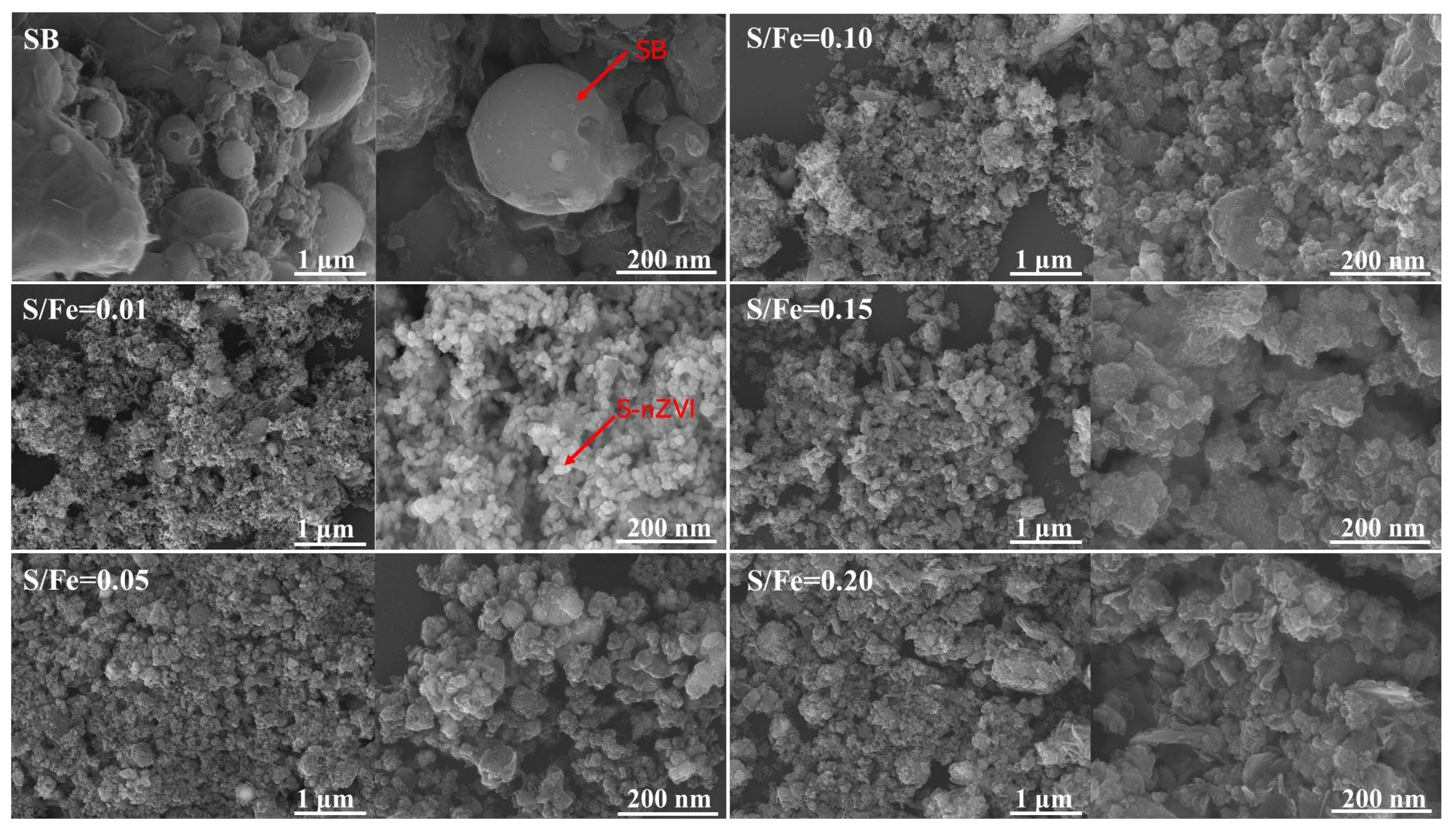



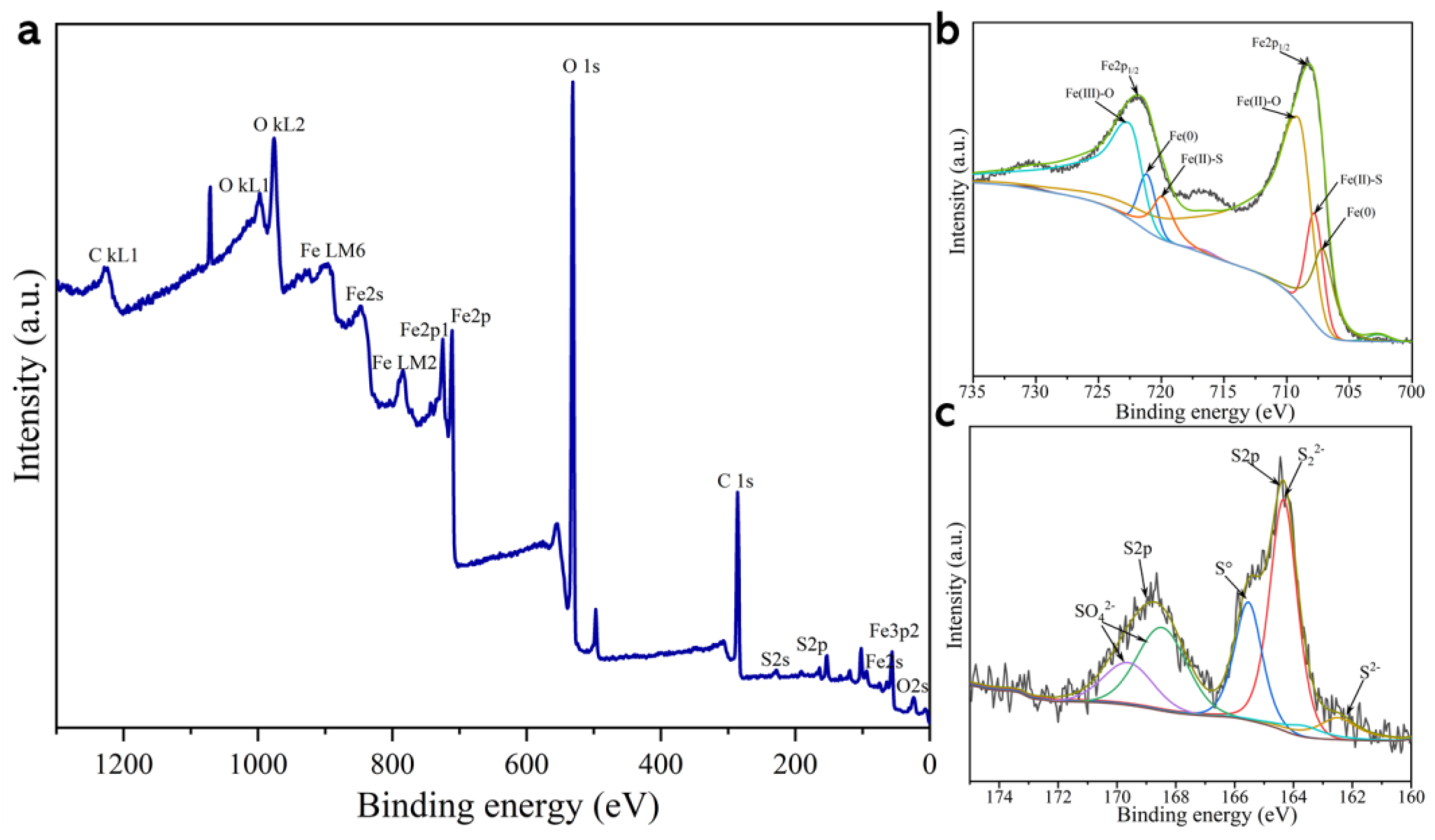
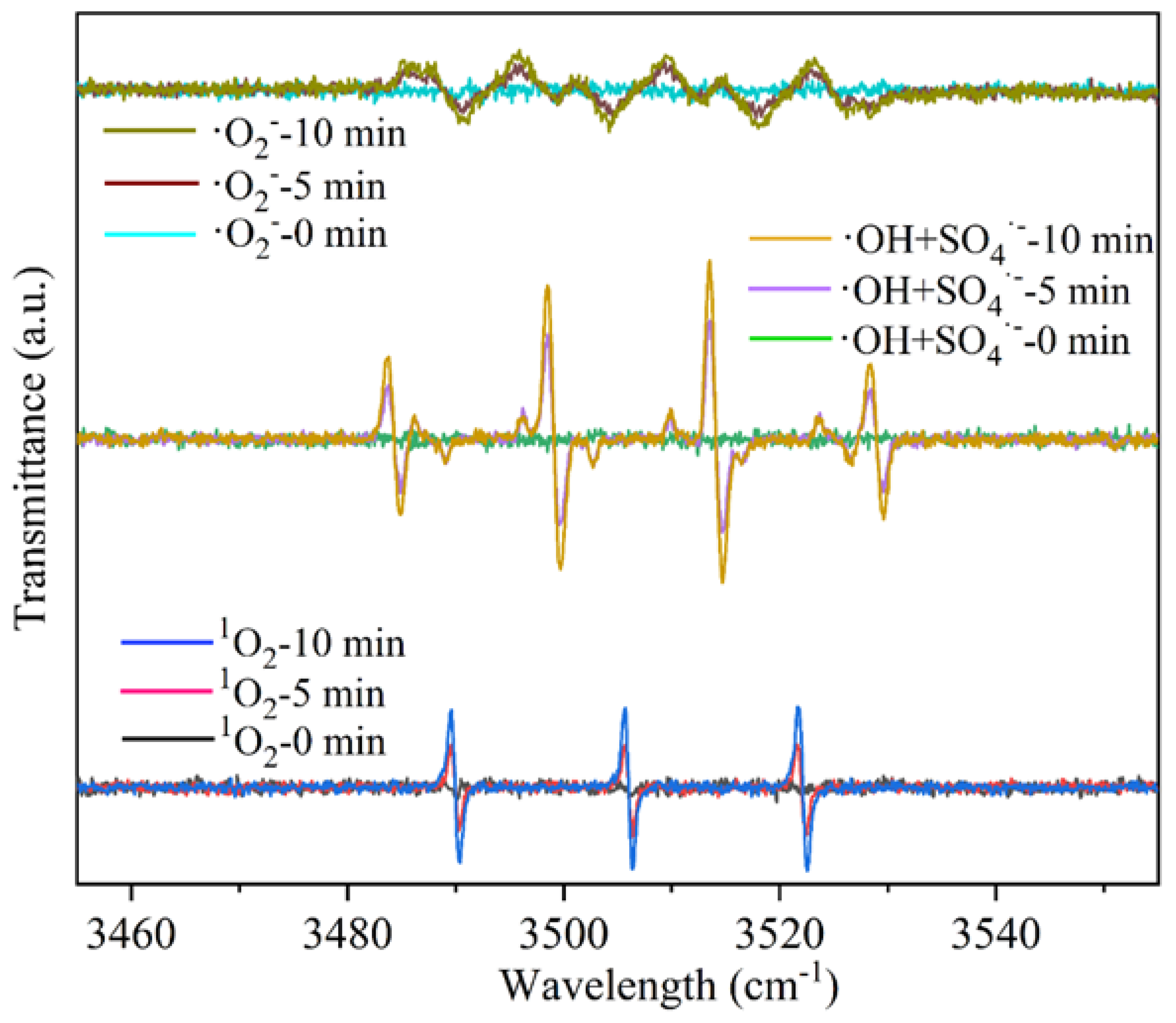
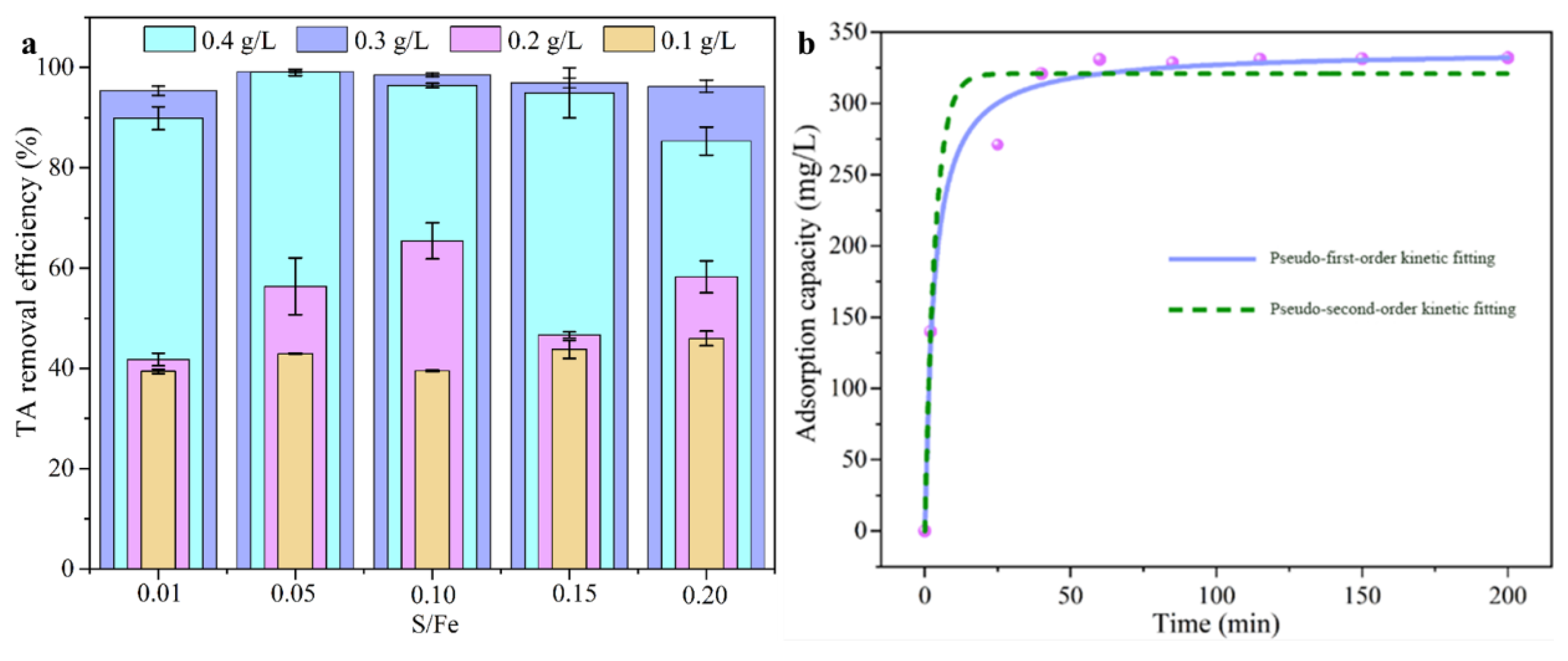
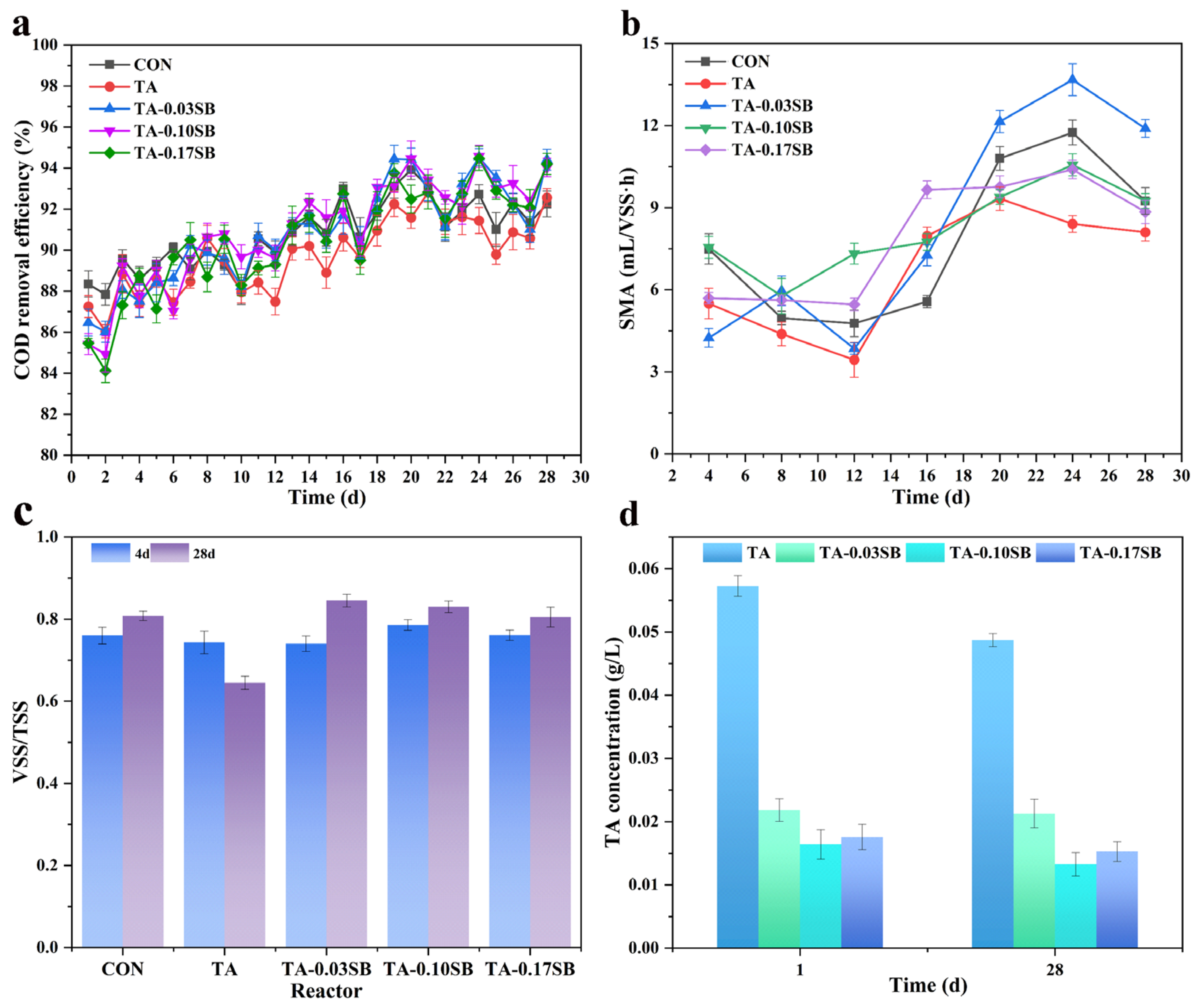

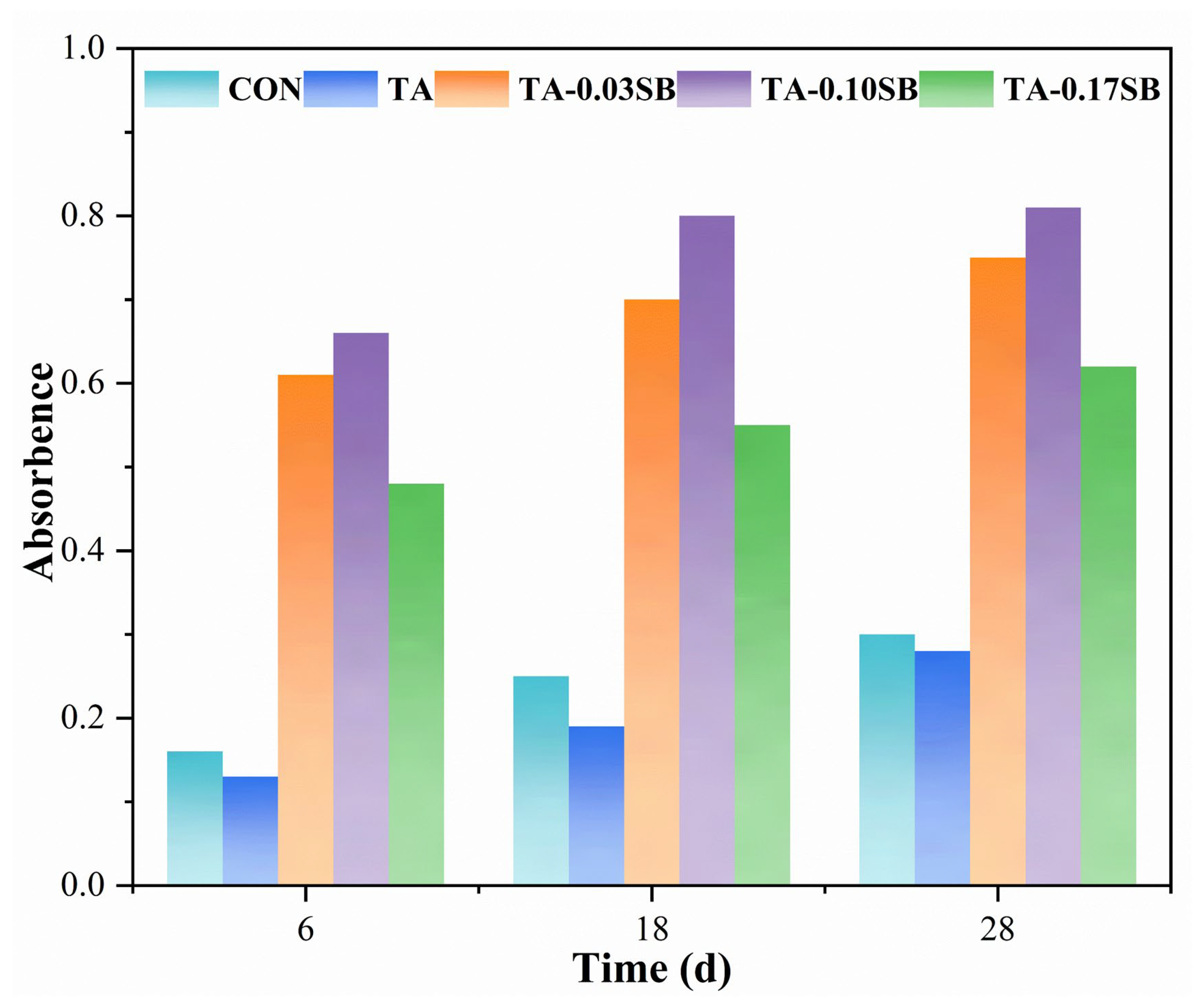

| Dynamic Model | Psuedo-First-Order Dynamics Model | Psuedo-Second-Order Dynamics Model | ||||
|---|---|---|---|---|---|---|
| Parameter | qe (mg·g−1) | k1 (min−1) | R12 | qe (mg·g−1) | k2 (g·mg· min−1) | R22 |
| SB-S-nZVI0.05 | 320.8382 | 0.2841 | 0.9695 | 337.0806 | 9.6631 | 0.9902 |
Disclaimer/Publisher’s Note: The statements, opinions and data contained in all publications are solely those of the individual author(s) and contributor(s) and not of MDPI and/or the editor(s). MDPI and/or the editor(s) disclaim responsibility for any injury to people or property resulting from any ideas, methods, instructions or products referred to in the content. |
© 2025 by the authors. Licensee MDPI, Basel, Switzerland. This article is an open access article distributed under the terms and conditions of the Creative Commons Attribution (CC BY) license (https://creativecommons.org/licenses/by/4.0/).
Share and Cite
Gao, Q.; Zhai, W.; Fu, W.; Liu, L.; Zhu, Y.; Jiang, K.; Zhu, S.; Zhao, K.; Qiu, Z.; Wang, C.; et al. Sulfidated Nano Zero-Valent Iron Sludge Biochar Composites for Efficient Tannic Acid Removal and Enhanced Anaerobic Digestion. Processes 2025, 13, 1084. https://doi.org/10.3390/pr13041084
Gao Q, Zhai W, Fu W, Liu L, Zhu Y, Jiang K, Zhu S, Zhao K, Qiu Z, Wang C, et al. Sulfidated Nano Zero-Valent Iron Sludge Biochar Composites for Efficient Tannic Acid Removal and Enhanced Anaerobic Digestion. Processes. 2025; 13(4):1084. https://doi.org/10.3390/pr13041084
Chicago/Turabian StyleGao, Qian, Wenxia Zhai, Wencai Fu, Ling Liu, Yunpeng Zhu, Keyang Jiang, Sijia Zhu, Kaize Zhao, Zhaodong Qiu, Congcong Wang, and et al. 2025. "Sulfidated Nano Zero-Valent Iron Sludge Biochar Composites for Efficient Tannic Acid Removal and Enhanced Anaerobic Digestion" Processes 13, no. 4: 1084. https://doi.org/10.3390/pr13041084
APA StyleGao, Q., Zhai, W., Fu, W., Liu, L., Zhu, Y., Jiang, K., Zhu, S., Zhao, K., Qiu, Z., Wang, C., Zhao, Y., & Wang, Z. (2025). Sulfidated Nano Zero-Valent Iron Sludge Biochar Composites for Efficient Tannic Acid Removal and Enhanced Anaerobic Digestion. Processes, 13(4), 1084. https://doi.org/10.3390/pr13041084







